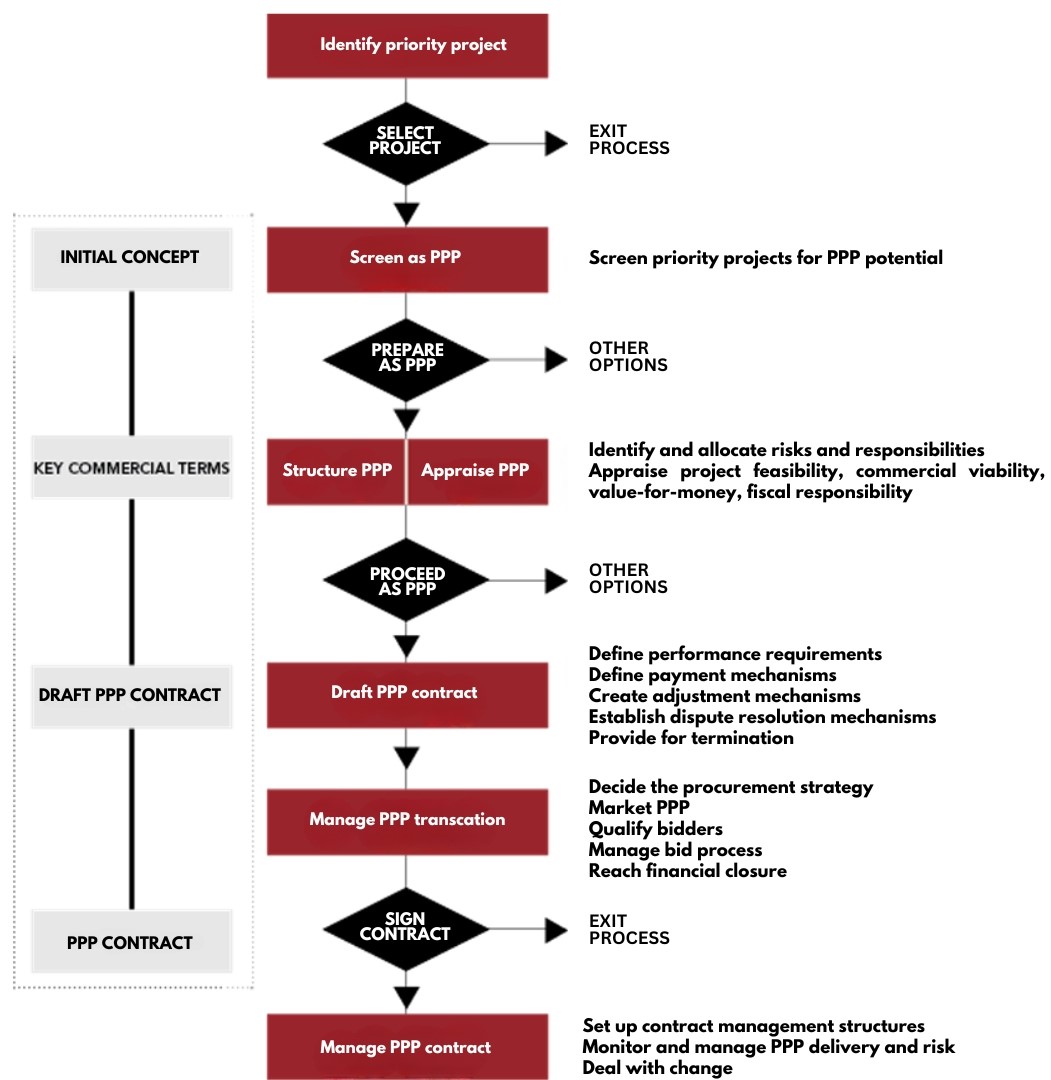12.4: Collaboration and Partnerships

Another trend in public procurement is the adoption of collaborative procurement strategies.
Public-Private Partnerships
Public-private partnerships (PPP) represent an approach to procuring government materials and services that is radically different from traditional public procurement. It moves beyond the client-supplier relationship when the government hires private companies to supply assets or services. PPP is a partnership between the public and private sectors to achieve a solution and deliver an infrastructure service over the long term. It combines the strength of the public sector’s mandate to deliver services and its role as regulator and coordinator of public functions with the private sector’s focus on profitability and commercial efficiency.
Transparent, competitive selection of the private partner is fundamental to providing a level playing field, foreseeable processes and the best price, terms and conditions for the government. Instead of proposing a single model, it takes the elements that will together make up an effective custom PPP framework for each partnership. Successful PPP frameworks have clear, well-understood and documented policies. The PPP policy must clarify to stakeholders (public and private) how the government wants to undertake PPPs. The policy should include:
- Purpose of the PPP policy: vision, mission and goals
- Definition of PPP projects
- Identification of responsibilities amongst government entities
- The different stages of the project at which government approval must be sought
- Conditions for the allocation of government support or liabilities.
Exhibit 12.2 provides an overview of each stage of a public-private partnership project.

Collaborative Initiatives
Collaborative implementation arrangements such as consultative in-house service delivery, contracting-out, commissioning, co-management, co-production and certification represent alternative arrangements through which collaboration can be introduced directly in policy implementation and public service delivery (Kekez et al., 2018).
Collaborative arrangements can only be effective if the government can create meaningful opportunities for interaction and mobilize different stakeholders to invest energy, resources and knowledge in the collaborative production of public services (Kekez et al., 2018). While most on-the-ground modes do not always attain their highest potential, the success of collaborative arrangements is highly dependent on these political competencies, which enable governments to mobilize and maneuver the meaningful contribution of non-governmental stakeholders to the implementation process.
However, while the success of all collaborative modes of service delivery is linked to political capacities, each collaborative arrangement has a need for a certain critical analytical or managerial capability which serves as its own “Achilles Heel” (Kekez et al., 2018). That is, as set out in Table 12.2, they each need at least one specific capacity, which, if missing, means they are unlikely to function as intended and will generate policy failures rather than the successes wished upon them.
| Resource Level Skill Dimension | Individual Capabilities | Organizational Capabilities | System Capabilities |
|---|---|---|---|
| Analytical Competencies | Policy Analytical Capacity CONTRACTING-OUT Domain knowledge and analytical skills as a base for effective negotiation and administration of contracts. |
Organizational Information Capacities COMMISSIONING Appropriate alignment of budget and other policy inputs with outputs and outcomes. |
Knowledge System Capacity CONSULTATION Institutions and opportunities for knowledge generation, mobilization and use. |
| Managerial Competencies | Managerial Expertise Capacity CO-PRODUCTION Motivation and ability of service providers to engage in creation of knowledge and quality together with citizens, networks and communities. |
Administrative Resource Capacity CO-MANAGEMENT Management of partnerships embedded in the trust, social capital and reciprocity between involved organizations. |
Accountability and Responsibility System Capacity CERTIFICATION State regulation and transparent adjudicative system ensuring that trust and system-level legitimacy of third-party certifiers is maintained. |
| Political Competencies (Required by all service delivery arrangements involving collaboration) |
Political Acumen Capacity Judgment about when and how to bring in the interactivity in the service delivery process. |
Organizational Political Capacity Framing conditions and milestones for joint action and empowering public managers to facilitate collaboration. |
Political-Economic System Capacity Government enjoys trust from the society in large and is able to mobilize actors and resources. |
Source: Adapted from Kekez, Howlett and Ramesh (2018).
Finally, even though it features minimal government participation, certification still requires state regulatory and managerial capabilities in gaining and maintaining community acceptance of third-party certifiers and in keeping certifiers honest and accountable. In this mode of collaboration, legitimacy and trust are key aspects of the certifying organizations and predictors of the the success of voluntary certification arrangements (Bernstein and Cashore 2007; Kekez et al., 2018). While the assistance of skillful governmental officials and strategists is crucial for building legitimacy and authority of third-party certifiers, trust between the public and certifiers and between the certifiers, certified companies and governments can be maintained only if certification standards are supported by functional accountability and adjudicative systems. Concerns about second-class regulation or corrupt standards can easily undermine years of work building up a certified brand (Zelli et al., 2017).
Procurement Playbook
Watch this video to get a better overview of the Canadian Collaboration Procurement Initiative.
Source: Public Services and Procurement Canada (2023, Aug 2). Buying Together: Overview of the Canadian Collaborative Procurement Initiative. [Video]. YouTube.
Real Cases in Public Procurement: Learning from Experience
Expanded Participation in Group Buying in Canada
Issue: The Canadian Collaborative Procurement Initiative (CCPI) pilot project was launched in 2022.
Background: Cooperative Purchasing or Group Buying is an arrangement where multiple organizations combine their buying requirements to enhance their purchasing power, creating volume discounts. This joint spending practice has been used in the private sector for years. It was recorded in 1945 when a group of farmers could not meet their individual needs, so they grouped together to create a stronger whole. Cooperative purchasing is increasing in Canada, with multiple government organizations pooling their buying power and purchasing from the same pre-existing contract. A competitive solicitation will first be released to establish these contracts, and then more than one award can be made for a single requirement from multiple buyers.
Cooperative purchasing is now spread across all levels of government in Canada. At the federal level, PSPC created the Canadian Collaborative Procurement Initiative (CCPI), an agreement through which provincial and territorial governments and municipalities, academic institutions, schools and hospitals (MASH sector entities) can use existing federal procurement tools to purchase commonly used goods and services at reduced costs.
Outcome: The group buying project now allows participants to share their needs. Other regions can assist in developing the strategic addition of commodities on offer. The CCPI has increased the standardization of procurement data history and created best practices with reporting requirements.
Discussion Questions
- How will growing group buying in the public sector change the procurement processes?
- Will this create any challenges with ethical business practices?
Source: Based on information from: https://www.canada.ca/en/public-services-procurement/services/acquisitions/collaborative-procurement-opportunities-governments-other-eligible-organizations.html
Checkpoint 12.4
Image Description
Exhibit 12.2: The image depicts a flowchart outlining the production process of a Public-Private Partnership (PPP) project. It is organized into several sequential stages alongside descriptive text, highlighting decision-making points and actions required throughout the process. The left side lists four main stages: Initial Concept, Key Commercial Terms, Draft PPP Contract, and PPP Contract. The right contains a detailed, step-by-step breakdown for each stage with a mixture of rectangular and diamond shapes, indicating actions and decision points.
The process begins with “Identify priority project” in a burgundy rectangle, leading to “Select Project” within a diamond shape, with options to either continue or “Exit Process.” Each subsequent stage follows a similar pattern: screening, preparing, structuring, appraising, drafting, managing, and signing contracts. At each decision point, there are arrows indicating alternative options or continuation.
Next to some stages, tasks are listed, providing specific instructions for each process phase.
Overall, the diagram visually structures the PPP progression from the initial concept through contractual completion, emphasizing key decision junctures and actions.
Attribution
“12.4 Collaboration and Partnerships” is remixed and adapted from the following:
Creating a Framework for Public-Private Partnership Programs: A Practical Guide for Decision-Makers by Jeffery Delmon, copyright © 2015 World Bank, Washington, DC, used under a Creative Commons – Attribution 3.0 IGO License, except where otherwise noted.
“Collaboration in Public Service Delivery: What When and How,” copyright © 2019 by Anna Kekez, Michael Howlett and M. Ramesh in Collaboration in Public Service Delivery: Promise and Pitfalls and used under a Creative Commons – Attribution 3.0 Unported License, except where otherwise noted.
Exhibit 12.2 is taken from Creating a Framework for Public-Private Partnership Programs: A Practical Guide for Decision-Makers by Jeffery Delmon, copyright © 2015 World Bank, Washington, DC, used under a Creative Commons – Attribution 3.0 IGO License, except where otherwise noted.
The multiple choice questions in the Checkpoint boxes were created using the output from the Arizona State University Question Generator tool and are shared under the Creative Commons – CC0 1.0 Universal License.
Image descriptions and alt text for the exhibits were created using the Arizona State University Image Accessibility Creator and are shared under the Creative Commons – CC0 1.0 Universal License.

